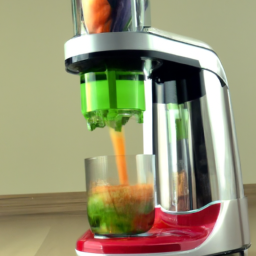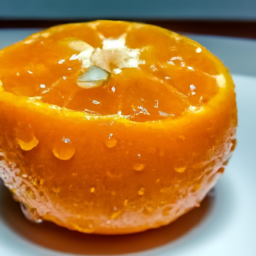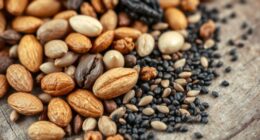I have always had a preference for cold-pressed juices and love experimenting with different flavors and ingredients. There is a refreshing feeling that comes from a cold glass of juice made from fresh fruits and vegetables, not to mention the health benefits.
If you’re interested in learning how to make your own cold-pressed juice, you’ve come to the right place. In this article, I’ll be sharing my tips and tricks for making delicious and nutritious cold-pressed juice right in your own kitchen.
We’ll start by discussing the benefits of cold-pressed juice and how to choose the right ingredients. Then, we’ll move on to the preparation and cleaning process, as well as operating your juicer. I’ll also share some ideas for mixing and matching flavors, storing your juice, and making your juice more nutritious.
Finally, we’ll wrap up with some recipes for cold-pressed juice and tips for juicing for a cleanse. So, grab your favorite fruits and veggies and let’s get started!
Key Takeaways
- Cold-pressed juice retains more nutrients and can be customized to individual taste preferences.
- Choosing fresh, organic, and seasonal produce is important for creating a delicious and nutritious beverage.
- Proper preparation, juicing, and storage techniques are essential for making cold-pressed juice.
- Juicing should be balanced with a healthy diet and exercise, and caution should be taken when juicing for a cleanse or for those with certain medical conditions.
Benefits of Cold-Pressed Juice
One of the main benefits of cold-pressed juice is that it retains more nutrients than traditional juice-making methods. This is because cold-pressing uses a hydraulic press to extract juice from fruits and vegetables, which produces less heat and oxidation than other methods. This gentle process helps to preserve the enzymes, vitamins, and minerals in the fruits and vegetables, making cold-pressed juice more nutrient-dense than other types of juice.
In addition to the nutritional benefits, cold-pressed juice can also be customized to suit individual taste preferences. With a wide variety of fruits and vegetables to choose from, it’s easy to create a blend that is both delicious and nutritious. Whether you prefer a sweet and fruity juice or a more earthy and vegetable-based blend, there are endless possibilities when it comes to making cold-pressed juice.
So, let’s move on to the next section and learn how to choose the right ingredients for your cold-pressed juices.
Choose the Right Ingredients
When it comes to choosing the right ingredients for cold-pressed juice, I always prioritize fresh produce. It’s important to consider whether to use organic or conventional fruits and vegetables as well, as some pesticides can be harmful to our health.
Additionally, I like to go for seasonal fruits and vegetables to ensure maximum freshness and flavor. By keeping these key points in mind, you can create delicious and nutritious cold-pressed juices at home.
Fresh Produce
With a variety of fruits and vegetables at my fingertips, crafting a cold-pressed juice is like conducting a symphony of flavors. Fresh produce sourcing is key to creating a delicious and nutritious beverage.
I love to visit farmers markets to find unique and seasonal ingredients. Here are some tips for selecting the freshest produce:
- Choose fruits and vegetables that are in season to ensure optimal flavor and nutrition.
- Look for produce that is firm and free of bruises or blemishes.
- Opt for organic produce whenever possible to avoid pesticides and other harmful chemicals.
- Smell the produce to ensure it’s fresh and ripe.
- Avoid pre-cut fruits and vegetables as they may have lost some of their nutritional value.
When it comes to cold-pressed juices, using fresh and high-quality ingredients is essential. In the next section, I’ll discuss the differences between organic and conventional produce and how it can impact your juice.
Organic vs. Conventional
Choosing organic produce over conventional can have a significant impact on your health and the environment, so it’s important to be informed. Organic farming uses natural methods to grow fruits and vegetables, without the use of synthetic fertilizers, pesticides, and genetically modified organisms (GMOs). This means that organic produce is free from harmful chemicals that can pose health risks to consumers and the environment.
In addition, organic farming practices promote soil health and biodiversity, which can lead to better crop yields and a more sustainable food system. When deciding between local and imported organic produce, it’s important to consider the environmental impact of transportation and the fair trade practices of the company. As a consumer, it’s important to be aware of labeling regulations and to support companies that prioritize organic farming and sustainable practices. With this knowledge, you can make informed choices about the food you eat and its impact on both your health and the environment.
As we move into the topic of seasonal fruits and vegetables, it’s important to keep in mind the benefits of choosing organic produce and how it can contribute to a healthier and more sustainable food system.
Seasonal Fruits and Vegetables
You’ll love the variety of seasonal fruits and vegetables available to you! Not only do they taste delicious, but they also provide a host of nutritional benefits.
Seasonal availability means that these fruits and vegetables are at their freshest and most flavorful, making them the perfect addition to your cold-pressed juice.
To make the most of seasonal produce, try incorporating a variety of fruits and vegetables into your juice. Some examples include:
- Summer: watermelon, cucumber, pineapple
- Fall: apples, pears, squash
- Winter: oranges, grapefruit, kale
- Spring: strawberries, spinach, carrots
By using seasonal produce, you can ensure that your juice is packed with vitamins, minerals, and antioxidants that your body needs. Plus, buying in-season fruits and vegetables can be more affordable and eco-friendly.
Now, onto preparation and cleaning.
Preparation and Cleaning
First, it’s important to note that according to a study by the USDA, leafy greens are one of the most commonly contaminated produce items, so be sure to thoroughly wash them before juicing.
Start by rinsing your fruits and vegetables under running water to remove any dirt or debris. Then, use a vegetable brush to scrub the produce, especially for items with a thick skin such as apples or cucumbers.
For leafy greens, fill a large bowl with cold water and let them soak for a few minutes before rinsing them again.
After cleaning your produce, it’s time to prepare them for the juicer. Cut your fruits and vegetables into smaller pieces to fit into the juicer chute, removing any seeds or pits.
For leafy greens, roll them up tightly before feeding them into the juicer, as this will help extract more juice.
With these cleaning tips and proper juicing technique, you’ll be well on your way to creating delicious and healthy cold-pressed juices.
Moving on to the next step, let’s talk about operating your juicer.
Operating Your Juicer
Now it’s time to get your hands dirty and start using your juicer to create the most amazing, nutrient-rich beverages. Before you start, make sure you’ve read the user manual and understand how to operate your specific juicer. Different juicers have different settings and methods of operation, so it’s important to be familiar with yours before you begin.
Once you’re ready to start juicing, begin by washing your fruits and vegetables thoroughly. Cut them into small pieces that’ll fit easily into the juicer chute. As you juice, be sure to monitor the pulp buildup and empty it frequently to prevent clogging.
After juicing, clean the juicer thoroughly to prevent any buildup or damage. Proper juicer maintenance will ensure that it continues to work efficiently and effectively. If you encounter any issues with your juicer, refer to the user manual for troubleshooting tips or contact the manufacturer for assistance.
Now that you know how to operate your juicer and keep it in good condition, you’re ready to start experimenting with different flavor combinations. Mixing and matching flavors can be a fun and creative process, so don’t be afraid to try new things.
In the next section, we’ll discuss some tips for creating delicious and healthy juice blends.
Mixing and Matching Flavors
Mixing and matching flavors is one of my favorite parts of making cold-pressed juice. Creating balanced combinations is key to making sure that the juice tastes great and provides all the necessary nutrients.
I love experimenting with different ingredients to find new flavor profiles that work well together. Adding herbs and spices can also add depth and complexity to the juice, making it even more enjoyable to drink.
Creating Balanced Combinations
Combining ingredients for cold-pressed juice is like creating a symphony, with each element playing an important role in achieving a balanced and harmonious blend. When making juice, it’s important to balance sweetness and acidity to achieve a well-rounded flavor.
Adding too much sweet fruit can overpower the juice, while too much acidity can make it too tart. Mixing fruit and vegetable juices is another way to create a balanced combination. Vegetables like kale, spinach, and cucumber add essential vitamins and minerals while balancing the sweetness of fruit juices.
To create a balanced blend, consider using a ratio of 2:1 or 3:1 for vegetables to fruit. Additionally, adding herbs like ginger, mint, or basil can enhance the flavor profile and add additional health benefits. Experimenting with different ingredients is key in finding your favorite combinations.
Don’t be afraid to try new fruits and vegetables or adjust the ratios to your liking. Creating cold-pressed juice is a fun and creative process that can lead to delicious and nutritious results.
Experimenting with Different Ingredients
To discover your personal favorite combinations of cold-pressed juice flavors, don’t be afraid to experiment with various fruits, vegetables, and herbs. Mixing and matching different ingredients will allow you to create unique flavor profiles that suit your taste buds. When experimenting, try to balance bitter, sweet, and acidic flavors, and keep in mind that some ingredients, like ginger or lemon, can add a refreshing kick to your juice.
To help you get started, here is a table of some popular ingredient combinations for cold-pressed juice:
| Fruits | Vegetables |
|---|---|
| Pineapple | Carrots |
| Apple | Cucumber |
| Orange | Kale |
| Grapefruit | Beetroot |
| Watermelon | Spinach |
Remember, this is just a starting point. Don’t be afraid to mix and match ingredients to create your own unique flavor experiments. In the next section, we will discuss how to add herbs and spices to enhance the flavor of your cold-pressed juice.
Adding Herbs and Spices
Spicing up your cold-pressed concoctions with aromatic herbs and exotic spices can unleash a whole new world of flavor sensations. Here are some herbs and spices that can take your juice from ordinary to extraordinary:
-
Ginger: This spicy root adds a zingy kick to any juice. It’s also great for digestion and has anti-inflammatory properties.
-
Mint: Refreshing and cooling, mint is perfect for hot summer days. It also aids in digestion and can help relieve nausea.
-
Turmeric: This vibrant yellow spice has a warm and earthy flavor. It’s a powerful anti-inflammatory and antioxidant.
-
Cinnamon: Sweet and warming, cinnamon is perfect for fall and winter juices. It also has blood sugar balancing properties.
By experimenting with different herbs and spices, you can create unique flavor combinations that suit your taste buds and nutritional needs. Once you find your favorite combinations, it’s important to store your juice properly to maintain its freshness and nutrient content.
Storing Your Juice
Make sure you store your cold-pressed juice properly to keep it fresh for longer! Long term storage can be achieved by freezing your juice, which can last up to 6 months. However, if you want to drink your juice within a week, refrigerating it is the best option.
Here are some refrigerator options for storing your cold-pressed juice:
| Option | Pros | Cons | How to Do It |
|---|---|---|---|
| Glass Bottles | Keeps juice fresh and free from toxins | Can be heavy and breakable | Fill the bottle to the top to minimize air exposure |
| Airtight Containers | Easy to use and store | May not keep juice as fresh as glass bottles | Choose a container with a tight-fitting lid and store it in the refrigerator |
| Mason Jars | Inexpensive and easy to find | Can break if not handled carefully | Fill the jar to the top and store it in the refrigerator |
| Plastic Bottles | Lightweight and durable | Can leach toxins into the juice | Choose a BPA-free bottle and store it in the refrigerator |
By following these storage tips, you can make sure your cold-pressed juice stays fresh and delicious for as long as possible. Now, let’s talk about some tips for making your juice more nutritious.
Tips for Making Your Juice More Nutritious
Now that you know how to properly store your cold-pressed juice, let’s discuss some tips for making it even more nutritious.
One way to maximize the nutrients in your juice is by pairing your fruits and vegetables strategically. For example, adding a citrus fruit like orange or grapefruit to your green juice can increase the absorption of iron from leafy greens like spinach and kale. Adding ginger to your juice can also help with digestion and reduce inflammation.
Another tip for making your juice more nutritious is by using a variety of colorful produce. Different colors indicate different nutrients, so incorporating a rainbow of fruits and vegetables into your juice can ensure that you are getting a wide range of vitamins and minerals.
Additionally, using organic produce when possible can minimize exposure to harmful pesticides and chemicals.
Now that you know how to make your cold-pressed juice more nutritious, let’s dive into some delicious recipes to try at home.
Recipes for Cold-Pressed Juice
Are you looking for some tasty and nutritious juice recipes to try at home using fresh fruits and vegetables? Look no further! Cold-pressed juice is a great way to get your daily dose of vitamins and minerals, and it’s easy to make at home. Here are some of my favorite juice recipes that you can try:
| Fruit | Vegetable | Flavor Combination |
|---|---|---|
| Apple | Kale | Sweet and Earthy |
| Pineapple | Cucumber | Tropical and Refreshing |
| Orange | Carrot | Citrus and Sweet |
| Beet | Ginger | Earthy and Spicy |
To make these juices, simply cut up the fruits and vegetables and put them through a juicer. Mix and match the ingredients to create your own unique flavor combinations.
Juicing for a cleanse is a great way to give your body a break from processed foods and give it a boost of nutrients. But before we dive into the specifics of juicing for a cleanse, let’s first discuss the benefits of juicing and how it can improve your overall health.
Juicing for a Cleanse
If you’re looking to give your body a much-needed detox, juicing for a cleanse is a great option that can help improve your overall health and well-being. Extended juicing can provide numerous benefits, including increased energy, improved digestion, and clearer skin.
By incorporating fresh fruits and vegetables into your juice recipes, you’re providing your body with essential vitamins and minerals that it needs to function properly.
To incorporate juicing into your daily routine, it’s important to invest in a high-quality cold-pressed juicer and stock up on fresh produce. Plan your meals ahead of time and incorporate juices into your breakfast or snack routine.
It’s important to remember that while juicing can be a beneficial tool for cleansing and improving your health, it’s not a sustainable long-term solution. It’s important to balance your juice intake with a healthy, balanced diet and regular exercise.
Frequently Asked Questions
Can I use frozen fruits and vegetables in my cold-pressed juice?
Yes, I can use frozen produce in my cold-pressed juice without compromising its nutritional value. Frozen fruits and vegetables are picked at their peak and frozen immediately, retaining their nutrients. Simply defrost before juicing.
How long does it take to clean a cold-pressed juicer?
Cleaning a cold-pressed juicer takes around 10-15 minutes, depending on the model. Maintenance tips include rinsing the parts immediately after use and thoroughly cleaning with a brush and mild soap. Regular cleaning ensures a longer lifespan for your juicer.
Is it necessary to peel fruits and vegetables before juicing them?
Peeling fruits and vegetables before juicing is not necessary. Consuming whole fruits provides added benefits like fiber, while the nutritional value of peels is high. Keep in mind that some peels may affect taste and texture.
Can I make cold-pressed juice without a juicer?
Yes, alternative methods like using a blender or food processor can make cold-pressed juice without a juicer. However, the nutritional benefits may vary due to increased oxidation. It’s recommended to use a juicer for optimal results.
How often should I drink cold-pressed juice for maximum health benefits?
To maximize the health benefits of cold-pressed juice, I recommend consuming it regularly in recommended serving sizes. Using organic produce in your juice can also provide additional health benefits.
Conclusion
Overall, making cold-pressed juice can be a fun and rewarding experience that results in a delicious and nutritious beverage. It’s important to choose the right ingredients, properly prepare and clean your equipment, and mix and match flavors to create unique and tasty combinations.
Storing your juice properly and making small adjustments to increase its nutritional value can also make a big difference. Imagine yourself standing in your kitchen, surrounded by fresh fruits and vegetables, as you carefully operate your juicer and create a vibrant and colorful drink.
Each sip is packed with vitamins, minerals, and antioxidants, giving you an energizing boost and a sense of well-being. Whether you’re making juice for a cleanse or just to enjoy as a refreshing treat, the process of cold-pressing can be a satisfying and healthy way to incorporate more fruits and veggies into your diet.
So go ahead and give it a try – your taste buds and your body will thank you!
Ilana has been a vegan for over 10 years. She originally made the switch for health reasons, but soon found herself becoming more and more passionate about the ethical and environmental implications of a vegan lifestyle. Ilana is the author of The Graceful Kitchen, a blog all about veganism. She loves to cook up delicious and nutritious vegan meals, and share her recipes with others who are interested in leading a cruelty-free life. Ilana is also a strong advocate for using whole foods as the foundation of a healthy diet, and believes that going vegan is one of the best ways to achieve this.










